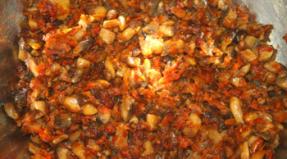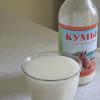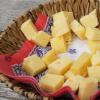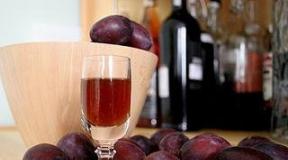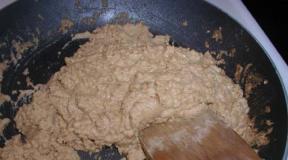Recommend an alcoholic drink grappa tincture. Grappa: what is it
An uninitiated person may sincerely be surprised: is there really any special way absorption of banal grape moonshine? But it wasn't there! For Italians, grappa is a cult drink, like cognac or champagne for the French. Therefore, any Italian will tell you how to drink grappa - the process of its consumption is distinguished by many subtleties and rituals.
Grappa and its variations
Grappa, in principle, was born as a result of savings - after making wine, Italian farmers always had a decent amount of waste, a kind of grape "cake". And then the psychological mechanism turned on - "what good is to disappear." So they began to drive moonshine from fermented illiquid assets. And he so relished the whole world that over time grape vodka- grappa began to be prepared in huge batches, including for export.
The strength of this drink is slightly higher than that of Russian vodka - up to 50 degrees. There are quite a few varieties of grappa, each of them has its own name, its own taste and aroma.
Firstly, grappa is divided into 4 types according to its age: there is a young one, just driven out, and an older one, with an aging period of 6, 12 or 18 months.
Drinks are aromatic, that is, made from special varieties grapes, or flavored - infused with additional ingredients like nuts or strawberries. Grappa is also divided according to the number of grape varieties used and the region of its growth.

Grappa - a peasant "sivuha" or a drink of aristocrats?
It is easy to imagine that initially grappa (unlike) was used by the poorest people - ordinary peasants who left wine for sale. There were no traditions of grape moonshine consumption at that time. Drink exclusively in pure form, ate bread and onions - that's all wisdom. In principle, even now grappa is rarely mixed with something, except that they can add it to coffee instead of rum.
But the process of consumption itself has grown over the centuries with a bunch of rituals. In Italy, there is even a special glass for this drink, reminiscent of a glass tulip on a stem - a wide "cognac" base and a neck tapering in the form of a tube. All in order to enjoy not only the taste, but also the aroma, because it is customary not only to savor grappa, sipping in small sips, but also to inhale its vapors.
To decide how to use grappa, you should first determine how old it is. It is customary to cool the young one slightly, and then drink it in one gulp, like our vodka. But grappa, aged in oak barrels for six months or longer, requires a reverent attitude. It is consumed at room temperature, and even slightly warm the glass in the palms to better feel the subtle smell of grapes.
Grappa is a symbol of Italy. This product of the alcohol industry comes from poor peasant families who have learned the secrets of distillation. Today, centuries later, it is sold along with elite, expensive alcoholic beverages, you can find it on the shelves with wine. Looking at the label, which says that the drink is forty degrees, you can assume that this is just vodka produced according to Italian technology. There are similarities in manufacturing, but still this is not vodka, but grappa. What's this? You can find out from our article.
Grappa - what is it?
The taste of this drink directly depends on the grape variety that was used for preparation. Initially, grappa was considered a purely masculine and cheap drink. Its taste was hard, the fortress interrupted the aroma of grapes, it was possible to drink it only in one gulp. This went on until the mid-sixties, until the Italian winemakers saw a "gold mine" in grappa. They quickly began to decorate the drink, first they changed the rough glass containers for elegant bottles, and then they began to improve the technology of preparation.
Grappa - what is it today? In modern times it's thoroughbred alcoholic drink produced in Italy. Bottles with her flaunt in expensive bars, now she has come out of the shadows and has become an elite drink that is drunk according to the rules. We will talk about how to drink grappa in the future content of the article.
How is grappa prepared?
When making wine, a lot of waste remains, these are the skin, bones, combs and small remnants of the pulp. Why throw away such goodness, if many centuries ago people found a use for this "garbage" and even gave it a name - cake, chacha (Georgian name) and many foreign names. By the way, what is the difference between grappa and chacha? Is the drink prepared using a similar technology and from the same raw material? You can find out about this and much more in the following content.
So, cake - the residue from the production of wine, is processed under pressure with water vapor, after which the liquid is fermented using granulated sugar and wine yeast. Subsequently, the process of distillation takes place in distillation columns with a continuous cycle, or in almabics (copper cubes intended for distillation).
The resulting distillate is too strong - about 80 degrees. In this form, it is impossible to consume it, and it is dangerous, so the process of dilution from 39 to 55 degrees takes place.

What is the difference between the new technology and the old one?
There are many varieties of grappa, and none of them is considered a cheaper option. Why was this drink previously cheap, but now it has become expensive and elite? The fact is that earlier, for making wine, juice from berries was taken to the maximum, and grappa was prepared from almost dry cake. She was rough and nasty. To eliminate these shortcomings, many experiments with the recipe were carried out. It turned out that with a residue of at least 35 percent in the juice cake, the alcoholic drink grappa completely changes its taste, from unpleasant it becomes fragrant and attractive.

Is there a grappa not made in Italy?
Is it possible to imagine real tequila not made in Mexico? Similarly, grappa, the photo of which is published here, cannot be a product of another country. The fact is that the drink is prepared only from the grapes that grow in the North of Italy. There, the berries ripen more slowly, they are more saturated with acid. Grappa is protected by law, in 2016, on July 16, the President issued a decree number 287 on the impossibility of considering grappa the drink that was made not only not in Italy, but also from grapes growing in the South of the country.
We suggest moving on to the next paragraph and getting acquainted with the varieties of grappa.
Giovane - young grappa
This drink also called "white", or Bianca. It has a sharp taste, or, as experts call it, brutal. At the same time taste qualities are regarded by the poor, but the aroma is rich and rich.
Young grappa is produced in the same way as other types, but the distillate is bottled immediately after distillation. The drink can also be kept a little in stainless steel containers. After many years of storage, this grappa does not change its taste.
If it is at least a little (six months) insisted in a wooden container, then it will acquire a more harmonious and mild taste. Such a drink is called Affinata.

old grappa
If you stand the distillate for a year, you get invecchiata, or vecchia. This drink is softer, more aromatic, and is considered the most popular type of grappa. Reviews about her experts are good. They say that it is enormously different in taste from the young.
Very old grappa
Drink aged in wooden barrels a year and a half, called rizerva or stravecchia, it acquires a rich aroma, "woody" flavor, becomes golden amber. In addition, the strength of the drink also increases, it increases from 45 to 50 degrees, but the taste does not deteriorate from this. It is considered the most expensive, elite variety of grappa.
Grappa, like whiskey, can be made from one grape variety, that is, single-varietal - monovitigno, or from several varieties, this is how multi-varietal grappa polivitigno is obtained.
Recently, on the shelves you can find a lighter grappa, which is prepared not from pomace, but from all grapes. Such a drink is called Aguavita Prime Uve. Reviews of such a grappa say that it is endowed with a rich wine aroma, it has a chic flavor bouquet, at the same time, the strength inherent in harsh drinks is felt.

How to recognize a real grappa?
In a bar or in a shop window, you can easily recognize this purebred drink, originally from Italy. The peculiarity of the packaging was appreciated by all connoisseurs of good alcoholic beverages. They write that the taste is pleasant, and the bottle pleases the eye.
Grappa is poured into triangular or figured bottles, reminiscent of perfume bottles. But it can also be flask-shaped containers, similar to containers from the laboratory.
The cork is always ground in, there is a wax seal. All these signs on the packaging are a guarantee of the authenticity of the drink.
Checking the quality of grappa is easy. To do this, you need to put two drops of the drink on your hand, rub it, wait half a minute. After that, the skin should smell like raisins, fried bread, spices. If none of these flavors emerge, then the quality of the grappa leaves much to be desired.

How to drink grappa?
This elite drink needs to proper consumption. For grappa, special, tulip-shaped wine glasses with a narrowed part at the "waist" have been created.
Many Italians, when they wake up in the morning, add a little grappa to their espresso coffee and call it caffee Corretto, that is, coffee-coretto, or improved, corrected coffee. This drink gives energy for a long time.
But grappa is still a digestif, that is, it is customary to consume it in the evening after good dinner. Outside Italy, grappa is heavily cooled, but this is wrong. The fact is that such a drink, like whiskey, is not able to fully open the bouquet when hypothermia.
If you have chosen a young grappa, then it is enough to cool it from 8 to 12 degrees. So the drink will not give out all too alcohol details, it will reveal the specifics of the aroma completely, and the aroma is main feature this type of grappa.
Old grappa should be between 16 and 18 degrees, to get it, you can use whiskey stones.
To fully appreciate the aroma of the drink, the glass should be held by the stem, so body odors will not interfere.
It is necessary to drink grappa in small sips, holding it for a few seconds on the tongue. In this way, you will be able to feel the whole bouquet of taste. They say that if you take this drink a little more than it would be enough for tasting, there will be no hangover in the morning.
Chocolate (bitter), ice cream, sweet desserts, fruits are suitable for grappa as a snack. If the drink was served for dinner, then vegetables, salads with seafood are ideally combined, but best of all - meat dishes.

Differences between grappa and chacha
Many people thought, after tasting grappa, that this is the same chacha. This is not at all the case, although the production is very similar. What are the differences?
- Country of growth of grapes, climatic conditions.
- Grape variety: in Italy they use Riesling Italico, Pinot Bianco, Sauvignon Blanc, Moscato, Barbera, and some others. In Georgia, the material for chacha is the cake of Isabella, Kachich and Rkatsiteli.
- In the preparation of chacha, other materials can also be used, these are the pomace of apricots, persimmons and other fruits, which is added to the pomace of grapes.
- Chacha is fermented naturally, unlike grappa.
- Chacha is aged in barrels made from local tree species. Grappa is aged only in Limousin oak cognac barrels.
- Chacha can be a fortress up to 70 degrees, grappa - up to 50.
Today we told all about grappa - an elite Italian drink. As it became clear, it differs greatly from chacha, but only experts can notice this by taste.
Grappa- This is a somewhat refined modification of Italian brandy, once popular among poor peasants and the urban poor. The difference between brandy and grappa is in the strength of 40 to 55 (brandy 40 - 60) degrees and in manufacturing process, about which you can read more.
Classic variant drink is made from the most marginal waste of winemaking: completely spent grape pomace, as well as its accompanying bones and ridges.
In the current industrial variation of grappa, the use of incompletely squeezed clusters is allowed, the addition of softening drinks fruit syrups, and blending of alcohols obtained from different grape varieties.
In addition, to obtain softer and at the same time more intense varieties of the drink, grappa can be aged for up to one and a half years (and often longer) in Limousin (cognac) oak barrels.
How to drink grappa
In the vast majority of cases italian drink grappa is recommended to drink in its pure form.
Varieties aged up to 18 months are usually consumed somewhat chilled.
The optimum temperature for this grappa is 8-12°C.
This allows you to muffle the brutal sharpness of the drink without compromising its flavor bouquet and aroma.
Chilled grappa is almost universal: it can be served with hearty hot dishes, chocolate, fruit and creamy desserts(emphasis should be placed on dark chocolate and citrus fruits) and, of course, as a traditional digestif. At the same time, during feasts, small glasses are offered for a drink, while the digestif is served in cognac or tulip-shaped glasses.
Although egalitarian grappa varieties can act as a digestif, in this case it is much more effective to use a higher quality drink. This is a grappa that has not left its barrel for a year and a half or more. It can be easily recognized by its characteristic light amber hue. It should be borne in mind that the use of such a drink is associated with the implementation of a number of strict rules.

As you know, unlike its less prestigious sisters, aged grappa is offered in a natural unchilled form. First, a glass filled ¾ full is examined by light in order to appreciate the noble shade of the drink and make sure that there is no sediment in it. Then the original aroma of grappa is slowly inhaled. All this time, the glass should be held exclusively by the leg, so as not to overheat the contents. And finally, you can proceed to the drink itself, savoring every sip.
Connoisseurs of aged grappa distinguish notes of pepper, vanilla, toasted bread, hazelnuts, almonds, raisins and peach in its taste.
Grappa in cocktails
If grappa in its pure form disgusts you, but at the same time something in it attracts you, use it in cocktails. The most popular drinks with grappa include Citrus, Clover and Italian Wife cocktails.
Grappa is the true embodiment of the Italian temperament in degrees of fortress. This is an amazing and original alcoholic drink. Being a product made from wine production waste, she conquered the world with her taste. Every year, about 40 million bottles of grappa are produced in Italy, which are distributed to all countries. After all, it is the drink produced on the territory of the republic that has the right to bear the proud name of Grappa. We bring to your attention the most complete and accurate intoxicating review.
The origin of grappa is inextricably linked with the advent of distillation methods. Distillation methods were developed in Mesopotamia between the 8th and 6th centuries. BC. and was soon applied to wines for the manufacture of cognac. The distillation of pomace probably also has very distant roots. There is a legend that tells of a Roman legionnaire (1st century BC) who, returning from Egypt, stole a distillation apparatus and began to receive distillate from grape pulp.
Historian Luigi Papo notes in 511 AD. in the area (Friuli) the first drink production in the hands of the Burgundians. They borrowed distillation methods apple cider from neighboring Austria and applied it to grape pomace, obtaining grappa.
The appearance of the Nardini distillery in Bassano del Grappa in 1779 led to real revolution through the introduction of the "steam distillation" method, which is still used today. In fact, Bortolo Nardini is the oldest distillery in Italy.
After the Second World War, Italian companies experienced a period of unprecedented growth. The Italians changed their way of life, followed by a radical change in tastes.
Grappa producers kept pace with the times and listened to the preferences of consumers. The taste of the drink became soft, less aggressive, it began to be aged for a long time in wood. So new types of grappa saw the light, scattered all over the world.
What is grappa
Grappa is essentially a distillate of grape pomace. Drinks obtained by a similar method are called differently in other countries. For example, in Germany it is Schnapps, in France it is Mark, in Spain and Greece it is Tsikudya. For Uruguay, European legislation does not apply, so the very similar term grappamiel (grappa with honey) is used there. Do not confuse grappa with brandy. The latter is the result of the distillation of grape must, not pulp.
The name of the drink most likely comes from the word "graspa", which in (Veneto) means "vine". There is an opinion that the product got its name from the province of Bassano del Grappa (Bassano del Grappa). However, there is no evidence of this fact.
Production
The quality of grape pomace is the first and most important factor for the production good drink. More often for grappa, the pulp left over from the production of red wines is used. Such pomace goes through the process of fermentation in the must, therefore they contain alcohol and only a small amount of sugar and do not need additional preparation.
In the manufacture of white wines, the pulp does not undergo fermentation, and therefore it is very rich in sugars and does not contain alcohol. She is called "vergini" (virgin). Wort for rose wine some time wanders along with the berries. Such a pulp is called "semifermentate". It already has some alcohol in it. Before the production of grappa, both types of the described raw materials go through a fermentation stage.
Grappa top quality requires the removal of stones from the pomace before distillation. And, all the more, it is very rare if the distillery uses pulp with an admixture of stems and leaves.
Distillation
For more than 50 years, automated distillation methods have been introduced in Italy. Modern distillers are a design of 3 connected devices in the form of a truncated cone. This provides the highest degree of purification from impurities. Such installations are characterized by a continuous distillation cycle, high power and relative simplicity of the manufacturing process.
Despite the mass positive properties, some beverage producers are of the opinion that grappa obtained in distillers with an intermittent (periodic) cycle is much better in quality. Therefore, in reputable factories, they cook it the old fashioned way or combine 2 methods.
Excerpt
Aging or ripening is an additional stage in the preparation of the drink, since the final step in obtaining a young grappa is filtration. So impurities of oils are removed and a crystal clear and transparent drink is obtained. After that, one grappa goes to bottles, the other - for maturation.
The aging process takes place in wooden barrels, usually with a volume of 225 liters. The appearance and taste of the final product depends on the type of wood with which it comes into contact. The most commonly used oak, acacia, ash and cherry.
A lighter drink comes out of the cherry containers. grappa from oak barrels It has amber and characteristic taste due to the high content of tannins in the wood. In addition to the type, the specific oak variety also affects the final aroma. Therefore, barrels are made from trees that grow not only in Italy. Another characteristic of the aging process is time. Depending on the duration of the stage, different types of grappa are obtained.
Kinds
Grappa is classified according to its age, the nature of the pomace and the grape variety responsible for the particular aroma. There are the following types of drinks:
- Giovanni (Giovanni)- young grappa, which remains in inert containers made of steel or glass until bottling.
- Aromatica- a drink obtained from aromatic grape varieties (Muscat, Malvasia).

- Affinata– grappa bottled after storage in wooden containers for 12 months.
- Invechiata (Invecchiata)- a mature drink, also called Vecchia (old), which is bottled after 12-18 months of aging in wooden containers.

- Stravecchia or Riserva- grappa, ripening for more than a year and a half in wooden containers.
- Monovarietale or "One Variety"- a drink made from grapes of a certain variety, which, as a rule, is indicated on the label.
- Polivitigno- a product from different grape varieties, but belonging to the same family. Such raw materials can be different in terms of ripening, harvesting time and winemaking technique.
- Flavored (Aromatizzata)- grappa, to which one or more natural vegetable oils have been added at the end of the distillation.
This, of course, is far from a complete classification of grappa. If we take into account the geographical origin, then many more options for the drink can be distinguished. All of them differ from each other in the centuries-old tradition inherent in the region and the culture of distillation. And, of course, one drink can refer to different types. For example, grappa can be young and flavored at the same time.
Manufacturers
There are about 130 different producers of grappa, of which 63% are located in the northeast of Italy.
At some distilleries, such as Rovero and Castelleri Bergaglio, the production of spirits accompanies the main one. Other factories (Poli and Nonino) are focused exclusively on the production of grappa and buy raw materials from winemakers. Nevertheless, from such a variety, several firms stand out that have earned respect and popularity among consumers:
- Berta is a company from with a very wide range of drinks. hallmark grappa from Bert is an unusual form of bottles combined with the highest quality of the drink.

- Bocchino (Bocchino) is a company that carefully preserves the traditional methods of distillation and grappa aging. Cellars for the maturation of the drink are dug into the hills. Bokkino produces 4 types of grappa with a strength of 40-50 degrees.
- Bortolo Nardini is the oldest factory associated with the Nardini family. Even today, the descendants of Bortolo continue the tradition of production.
- Vittorio Capovilla- a company primarily engaged in distillation fruit drinks and produces grappa in small quantities. Grappa di Bassano is especially appreciated with a strength of 41%.
- Marolo– distiller, combining modern equipment with traditional methods. A distinctive feature of the company is a wide range of not only drinks, but also sweet desserts with grappa.

- Nonino is a company representing the female quota in the standings of distilleries, since the Nonino family consists mainly of women. The company is always striving to revolutionize production methods while respecting tradition. All types of drinks obtained by Nonino deserve attention, but Grappa Cru Monovitigno Picolit can be emphasized. Her bottle is made in the form of a flask. She possesses mild taste with the aroma of honey and acacia flowers.
- Poly (Poli) is a company that produces a wide range of grappa in recognizable bottles with a long and narrow neck. The plant uses 2 distillation methods, producing drinks with a delicate taste.
- Romano LeviRomano Levi- a legend in the world of grappa. The plant still uses the direct distillation method with discontinuous cycle. Bottles decorate labels with unusual drawings intended for collectors.
There are many more producers of quality grappa than listed. When choosing a drink, you can focus not only on the brand, but also on the names indicating a specific region, the use of which is legally regulated:
- Grappa di Barolo;
- Grappa piemontese or del Piemonte;
- Grappa lombarda or della Lombardia;
- Grappa trentina or del Trentino;

- Grappa friulana or del Friuli;
- Grappa veneta or del Veneto;

- Grappa dell'Alto Adige;
- Grappa siciliana or Grappa di Sicilia;
- Grappa di Marsala.
The production of these types of grappa must meet certain standards. Companies that do not comply with the requirements for using the name "grappa" or geographical indication use the term "acquavite di vinaccia" to refer to the drink.
How is it different from chacha
Many consumers are wondering: “How is grappa different from chacha if they are obtained by similar methods?” At first glance, the difference between these “drunk sisters” is only in their homeland (chacha is a Georgian distillate made from grape pomace). In fact, this is far from the case.

Based on the above information, we can conclude that grappa and chacha are two different drinks “from roots to tips”.
How to taste and what to drink
Grappa tasting by professionals is a very precise process with strict requirements. It should take place in a room with light walls and good sound insulation, so that attention is focused only on the aroma of the drink.
Tasters are advised not to wear perfume, smoke, or eat or drink with bright tastes. If several types of grappa are involved in the process, then they start with a young one, move on to a fragrant one and finish with an aged one.
The optimum temperature of the drink is 9-13 degrees. Although mature grappa is an exception. It is served at 17 degrees.

The ideal glass for grappa is tulip-shaped and 10-15 cm high. It should be medium domed, made of crystal or sonorous glass. The neck of such a wine glass is narrow with an open crown. It promotes the gradual release of aroma.
- Recommended to visit:
The first evaluation of the grappa takes place visually through the light. If the drink is not flavored with oils, then any haze will be considered a defect. Next, the color is determined, while the young grappa, ideally, is absolutely colorless.
In order to appreciate the smell of the drink, the glass is held slightly away from the nose, trying to perceive the nuances, and not inhale the alcohol. Young grappa has a clear, fresh aroma with fruity accents. Ripe - full of notes of vanilla, cinnamon, licorice, cocoa and even tobacco.
To assess the taste, grappa is scrolled in small sips on the tongue for several seconds. This allows you to fully open up. taste buds. After each type of drink, it is recommended to drink half a glass of milk in order to “renew” the oral cavity.

If the purpose of your tasting is not to evaluate quality characteristics, but to have a good time with friends, then remember that grappa is a classic digestif. They drink it small doses after meals to aid digestion. In Italy, grappa is added to. The Italians call this drink caffè coretto, which means "corrected coffee".
A pleasant accompaniment to the grappa's own aroma will be salted pistachios and croutons with acacia honey, sprinkled with parmesan flakes.
Price
How original grappa is, so surprising is the range of prices for it. Buy in Italy strong drink maybe from 7-8 euros for 500 ml. But this is just the starting cost. Depending on the manufacturer, type and age of the drink, buying grappa can cost you even 600 euros for the same 500 ml.
In Russia, the cost of grappa starts from 1000 rubles for a drink of dubious quality. It comes up to 65,000 rubles for 500 ml for the collection Grappa with long term excerpts.
This heady information is completely exhausted. Live zealously, love honestly, travel passionately and remember: “Don’t put off for breakfast what you can drink at dinner!”
↘️🇮🇹 USEFUL ARTICLES AND SITES 🇮🇹↙️ SHARE WITH YOUR FRIENDS
you can spend a large number of personal time to search for and purchase original alcohol for personal tasting, but it is better to immediately turn your attention to the grappa drink.
This is an exclusive alcohol, which today is a representative of the premium Italian line.
These are products of the highest quality, whose taste and aroma penetrate into the heart of the consumer from the very first moments of tasting.
It is not a shame to treat invited guests with such a product and enjoy it for many hours of individual tasting.
Did you know? Most popular species Grappas are produced in northern Italy, in the Veneto region.

Considering the variety of alcohol on the market, you are guaranteed to pay a decent amount of attention to Italian grappa.
These are exquisite alcoholic assemblages, which are obtained by distilling the remains of grapes.
We are talking about the pulp, which includes the peel, bones, pulp and stems. Grappa is one of the subspecies of brandy, but its more accurate definition would be strong moonshine made from grape pomace.
Color
The visual performance of drinks can differ in a variety of visual displays, from pale gold to rich burgundy.
Aroma
The aromatic bouquet stands out with rich notes of grapevine, intertwined with fruity, berry and spicy tones.
Taste
Gastronomic foundation looms enticing softness of the wine and a long fruity aftertaste.
How to choose the right original product

Grappa - vodka with unique tasting characteristics, which should be chosen with extreme caution. The reason for this is the systematic increase in the number of counterfeit products in the international alcohol arena.
In particular, in order not to miscalculate and choose really quality alcohol try to keep the following points in mind.
- Bottle decoration. Modern producers of premium Italian alcohol approach each stage of product creation with full responsibility. It is for this reason that you will never find uneven labels, traces of glue, glass chips, damaged caps and other factory defects on licensed bottles.
- Container forms. The external design of bottles with aromatic strong assemblage can be very diverse. Each manufacturer supplies products in their own authentic packaging. Consequently, before purchase try in advance visit the official website of the manufacturer and get acquainted with how branded alcohol bottles look like.
- Place of purchase. When choosing premium alcohol trust only specialized shops. Do not look for premium products in stalls and grocery stores. Buy from places where you can get a certificate of quality.
- Excise stamp. On any foreign alcohol should be a tax stamp. This element of protection can be absent only on products sold in free trade zones.
- purity and viscosity. Be sure to look at the structure of the drink. It has a high degree of density and purity.. The branded assemblage stretches a little during the pouring process and will never upset you with sediment and other turbidity in the composition.
How to drink grappa

By purchasing instead real tincture from grape pulp, treat its tasting responsibly. In order for alcohol to give you the most vivid and pleasant impressions of consumption, be sure to take into account the generally accepted canons.
Aged varieties can be drunk at room temperature, while young ones, aged 1-2 years, are consumed strictly chilled. Optimum temperature feed in this case is considered to be an indicator of 5-10 degrees.
Alcohol is poured into special tulip-shaped wine glasses or into. The main thing is that they are transparent, and you can catch all the exquisite aromas of the assemblage. As for the consumption itself, the products are drunk in small sips with constant study of the unfolding aroma.
Did you know? Today, grappa is equated with premium products, but originally it was the alcohol of commoners who could not afford normal wine.
What do you drink grappa with?
Just like, Italian vodka on the pulp is snacked on almost any hearty meals. At the same time, experienced tasters recommend serving bitter chocolate, fruits, lemons, oranges, ice cream and other desserts to it.
In particular, perfect couple selected individually for the selected assemblage.
Other uses
In a classic serving, Italian grappa is not diluted with anything, but this way of tasting can quickly bore a modern fan of versatile strong products.
For this reason, experienced mixologists have created a range of cocktails that can greatly diversify a tasting evening.
to the most interesting and popular cocktails based on wonderful hard liquor include Boardage, Mint Grape, Citrus, Dolce, Clover, Venetian Sunset and Italian Wife.
Also, in search of diversity, you can ask a question, and in the answers to it you will find many mixes that are applicable to grappa as well.
What are the types of this drink

On the shelves of modern specialized stores, you can easily find a variety of pulp alcohol with exclusive tasting characteristics. The most interesting premium representatives of these products include:
- Grappa Nonino Riserva Antica Cuvee. It has a caramel-amber color and a complex aroma based on plumes of croissants and candied fruit. Gastronomic indicators emerge with delicate citrus, apricot, vanilla and almond overflows.
- Il Moscato di Nonino Monovitigno. Crystal clear and transparent alcohol with the aroma of sage, rose, grapes and sea breeze. In its taste, a bright proportion of rose hips and figs looms.
- Grappa di Sassicaia. Golden assemblage with rich aroma consisting of notes of coffee, vanilla, spices and cocoa. The gastronomic foundation is built on the combination hazelnut And .
- Traditional Nonino. Crystal clear assemblage with a soft fresh aftertaste of grapes. The aroma is expressed by a fragrant overflow of grapevine shades.
History reference
The first representatives of grappa appeared in Italy in the XI century. This drink was made by peasants in the city of Bassano del Grappa, from which the drink acquired its recognizable name.
The first written mention of the drink dates back to 1451. It was a will in which a notary from Piedmont bequeathed to his loved ones a certain amount finished product and a distillation apparatus for its manufacture.
In 1997, due to the rapid growth in the popularity of the drink, the Italian government issues a decree in which it prescribes the territorial affiliation of alcohol. Thus, today grappa can only be called italian alcohol made from local raw materials.
Did you know? Currently, the strength of aged varieties of grape pulp varies from 40 to 55 degrees.
Exclusive assemblages for every taste
Grappa - great option good . The popularity of these drinks continues to grow among novice connoisseurs. strong alcohol. The reason for this is the variety of flavor incarnations, adorned with the softness of a delicate wine.
These drinks can be purchased for personal tastings, as well as for mass festivities or for presentations.
These products, in addition to premium taste, often have a presentable appearance, which allows them to become a worthy accompaniment to any event in the blink of an eye.
Head to the nearest alcohol store for a bottle of colorful Italian assemblage that combines the strength of real brandy and the tenderness of the tasting characteristics of good wine.
